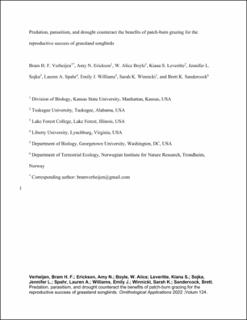| dc.description.abstract | Intensification of livestock production has reduced heterogeneity in vegetative structure in managed grasslands, which has been linked to widespread declines in grassland songbird populations throughout North America. Patch-burn grazing management aims to restore some of that heterogeneity in vegetative structure by burning discrete pasture sections, so that cattle preferentially graze in recently burned areas. Although patch-burn grazing can increase reproductive success of grassland songbirds, we know little about possible interactions with regional variation in predator communities or brood parasite abundance, or annual variation in weather conditions. Using six years of data from two tallgrass prairie sites in eastern Kansas, USA, we tested effects of patch-burn grazing on the rates of brood parasitism, clutch size, nest survival, and fledging success of three common grassland songbirds, Dickcissels (Spiza americana), Eastern Meadowlarks (Sturnella magna), and Grasshopper Sparrows (Ammodramus savannarum), among pastures managed with patch-burn grazing versus pastures that were annually burned and either grazed or ungrazed. Dickcissel nests experienced lower parasitism (72.8 ± 4.6% SE vs. 89.1 ± 2.2%) and Eastern Meadowlarks had higher nest survival (63.2 ± 20.5% vs. 16.5 ± 3.5%) in annually burned and ungrazed pastures than pastures managed with patch-burn grazing. However, average number of host fledglings per nesting attempt did not differ among management treatments for any species. Annual variation in weather conditions had a large effect on vegetation structure, but not on reproductive success. Probability of brood parasitism was consistently high (25.5‒84.7%) and nest survival was consistently low (9.9–16.9%) for all species pooled across treatments, sites, and years, indicating that combined effects of predation, parasitism and drought can offset potential benefits of patch-burn grazing management previously found in tallgrass prairies. Although differences in reproductive success among management treatments were minimal, patch-burn grazing management could still benefit population dynamics of grassland songbirds in areas where nest predators and brood parasites are locally abundant by providing suitable nesting habitat for bird species that require greater amounts of vegetation cover and litter, generally not present in burned pastures. brood parasitism, demography, Flint Hills, Kansas, nest survival, population dynamics, pyric-herbivory, rangeland management, songbird, tallgrass prairie | en_US |
